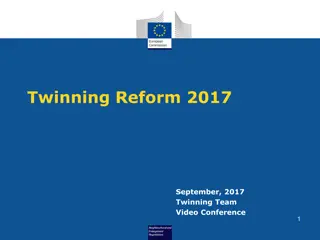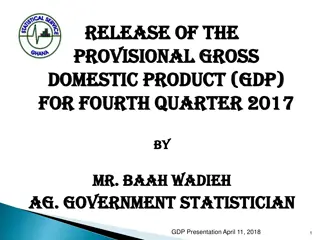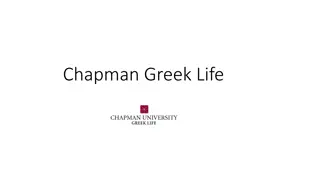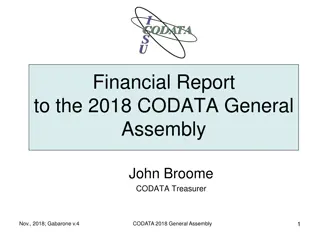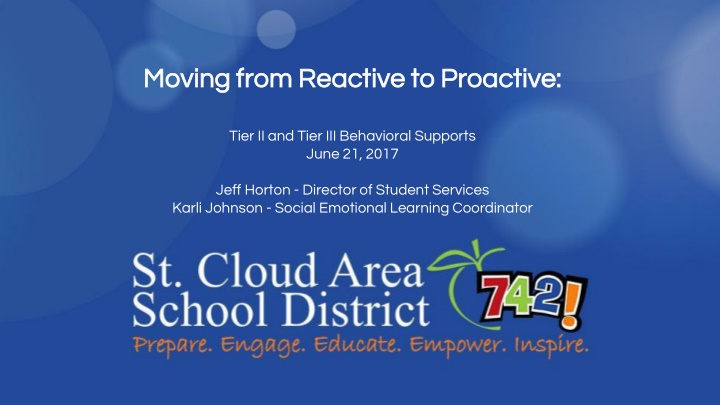
Proactive Strategies for Behavioral Support in Educational Settings
Explore the transition from reactive to proactive approaches in behavioral support within educational settings. Learn about tier II and tier III supports, conducting needs assessments, researching solutions, proposing to stakeholders, and funding strategies.
Download Presentation

Please find below an Image/Link to download the presentation.
The content on the website is provided AS IS for your information and personal use only. It may not be sold, licensed, or shared on other websites without obtaining consent from the author. If you encounter any issues during the download, it is possible that the publisher has removed the file from their server.
You are allowed to download the files provided on this website for personal or commercial use, subject to the condition that they are used lawfully. All files are the property of their respective owners.
The content on the website is provided AS IS for your information and personal use only. It may not be sold, licensed, or shared on other websites without obtaining consent from the author.
E N D
Presentation Transcript
Moving from Reactive to Proactive: Moving from Reactive to Proactive: Tier II and Tier III Behavioral Supports June 21, 2017 Jeff Horton - Director of Student Services Karli Johnson - Social Emotional Learning Coordinator
Welcome! Welcome! What is your current position? Does your district/school have PBIS? How long have you been doing PBIS?
Needs Assessment and Analyze Data Needs Assessment and Analyze Data Hexagon Tool Hexagon Tool School Climate Data School Climate Data District Climate Survey Office Discipline Referrals Suspension Data Focus Groups Focus Groups Community Input Community Input What does your district/school already have in place? What does it still need?
Hexagon Tool Hexagon Tool Exploring Context Exploring Context
Research Potential Solutions Research Potential Solutions Social Emotional Learning Competencies Positive Behavior Interventions and Support Restorative Practices Student Support Rooms Check and Connect
Propose Your Solution to Stakeholders Propose Your Solution to Stakeholders Board Committee Superintendent's Cabinet Directors Principals Staff
How are you going to pay for it? How are you going to pay for it? Achievement Integration Funds Alternative Delivery of Specialized Instructional Services (ADSIS) Alternative to Suspension Funds Strategic Funds
St. Cloud Student Support Room St. Cloud Student Support Room Vision Vision A systemic approach to proactively support as well as respond to student behavior and emotional needs. The program focuses on short, intense services and supports to build skills and fade away supports while simultaneously increasing student independence. The goal of the program is to see students exit and have independent success. The program will also support the school s need for ISS supports.
Purpose Purpose Provide an alternative learning opportunity for students for short periods of Provide an alternative learning opportunity for students for short periods of time. time. Proactive, planned breaks Responsive breaks through guidance of administration Group sessions (such as social skills groups) Short term plans with the goal of returning the student to the classroom full Short term plans with the goal of returning the student to the classroom full time. time. Utilizing fade away supports Provide an opportunity for hands on support for self calming and awareness. Provide an opportunity for hands on support for self calming and awareness. Increase student emotional and behavioral self awareness and calming Increase student emotional and behavioral self awareness and calming abilities. abilities.
Student Support Room Student Support Room Staff Staff BRS- Behavior Resource Specialist BSS- Behavior Support Specialist Behavior Tools Behavior Tools FBA- Functional Behavior Assessment PBIP- Positive Behavior Intervention Plan
Talahi Elementary Student Support Room Talahi Elementary Student Support Room
Student Referral Process Student Referral Process 1. 1.Teacher, Parent, or Administrative Recognition of an Increased Teacher, Parent, or Administrative Recognition of an Increased Need for Student Support. Need for Student Support. i. Functional Behavior Assessment 2. 2.MTSS MTSS i. Parent Permission slip ii. Review FBA iii. Discuss Positive Behavior Intervention Plan 3. 3.PBIP PBIP i. Short term objectives working towards reachable behavioral goals including remaining in classroom at increased time intervals. *Exception through administration for responsive action. FBA and BIP Resource: http://www.pbisworld.com/
Opportunities Opportunities Small group learning Small group learning Social Skills groups Friendship groups Lunch groups Celebration Lunches Push In Supports Push In Supports Proactive Breaks Proactive Breaks Planned energy breaks Check in/Check out Reactive response Reactive response
Expectations for Reactive Response Expectations for Reactive Response Reactive Response/ Urgent referral from Administration Reactive Response/ Urgent referral from Administration Communication from referral source Engage the student in the calming process, explain expectations gently Identify readiness to move forward after calming Engage with student Reflective conversations and processing with students Antecedent, triggers, personal response, personal responsibility Identify plan of action within Student Support Room Identify plan of action to return to class and manage emotions/behaviors Communicate transition plan Send Communication form
Expectations for Proactive Response Expectations for Proactive Response Students with Proactive Plans Students with Proactive Plans Be aware of the plan Identify readiness to move into plan or if calming time is needed prior Movement to plan area Academic, sensory, calming etc. Engage with student Identify if the student has appropriately utilized plan, offer praise, review transition plan. Communicate transition plan With proactive plans, communicating the transition plan following the first few days of the plan may not be necessary. Check with teacher to coordinate this communication. Send Communication form if needed
Requirements Post Student Contact Requirements Post Student Contact Documentation Documentation Attendance, time in/time out, race, referral source, purpose Family contact as needed Family contact as needed Be sure this is communicated across parties as to who will contact family. Communication with administration or child s team as needed Communication with administration or child s team as needed Referral concerns: Referral concerns: Safety concerns Home safety, abuse, neglect concerns referred to Guidance and/or Administration (mandated reporting) Medical or medication concerns referred to Nursing Recommendations for outside services can be made to the student s team Communicate concerns immediately and effectively to the appropriate party.
How Will You Collect Data? How Will You Collect Data? Student Information System Google Apps Microsoft Office Products Paper Other
Initial Professional Development Initial Professional Development Initial BRS Training Initial BRS Training 3 Trainings in September Focus on vision, process, data entry, FBA, PBIP Principals and Assistant Principals Principals and Assistant Principals All BRS trainings available for review Principal Meetings Assistant Principals Communication through Principal Playbook
Ongoing Professional Development Ongoing Professional Development BRS Training BRS Training Training Bi-monthly Connect, review Restorative Practice training Cultural Competency Provide work time away from building site/collaborate and brainstorm Summer 2017 Restorative Justice Conscious Discipline
Ongoing Professional Development Ongoing Professional Development BSS Training BSS Training Site Based Superintendent s Cabinet Presentations Superintendent s Cabinet Presentations At quarter or trimester Principal Training Principal Training Developed with support of the Superintendent's Cabinet
General Education Students and Special Education Students General Education Students and Special Education Students Utilizing Student Support Room Utilizing Student Support Room General Education Students: 28,050 (88.5%) Special Education Students: 3,643 (11.5%)
Proactive VS Reactive Response Proactive VS Reactive Response Districtwide February 2017 59% Reactive 41% Proactive Districtwide June 2017 55% Reactive 45% Proactive 55% 45%
Elementary Response Data Elementary Response Data June 2017
Questions Questions? ?


